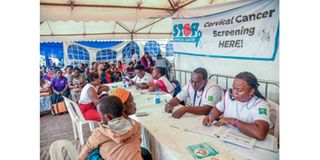WHO leads global initiative to end cervical cancer

Women waiting to be screened for cervical cancer in Uhuru Park, Nairobi, on January 23, 2020.
What you need to know:
- Strategy holds that 90 per cent of girls be fully vaccinated with the HPV vaccine by the age of 15.
- Seventy per cent of women should use a high-performance test by the age of 35, and again by 45.
The International Agency for Research on Cancer and the World Health Organisation have launched an ambitious strategy to guide the elimination of cervical cancer.
The two organisations are working with other partners through the Global Strategy to Accelerate the Elimination of Cervical Cancer.
The campaign comes as the world marks Cervical Cancer Awareness Month this January.
The strategy was adopted in August 2020 by the World Health Assembly. It holds that for countries to eliminate cervical cancer, they must reach and maintain an incidence of below four per 100,000 women.
It also holds that 90 per cent of girls be fully vaccinated with the HPV vaccine by the age of 15 and 70 per cent of women use a high-performance test by the age of 35, and again by 45.
On treatment, the strategy advocates that 90 per cent of women with pre-cancer treated and 90 per cent of women with invasive cancer managed.
Deadline
Each country is required to meet the targets by 2030.
“Cervical cancer is highly preventable and treatable. It could be the first cancer ever to be eliminated,” tweeted Tedros Ghebresyesus, WHO director general.
In 2020, about 604,000 women were diagnosed with cervical cancer worldwide, 342,000 of whom died from the disease. Nearly 90 per cent of deaths occurred in low- and middle-income countries, where the burden is greatest, as access to public health services is limited and screening and treatment have not been widely implemented.
Every year, more than 300,000 women of cervical cancer, with 90 per cent of the deaths occurring in the poorest countries.
Africa
Estimates by Lancet Global Health indicate that in 2018, 19 of the top 20 countries with the highest burden were in sub-Saharan Africa.
Eswatini had the highest incidence rate in 2018, with about 6.5 per cent of women developing cervical cancer before age 75 years, followed by Malawi.
China and India together contributed more than a third of the global cervical burden, with 106,000 cases in China and 97,000 cases in India, and 48 000 deaths in China and 60,000 deaths in India.
Globally, the average age at diagnosis was 53 years, ranging from 44 years (Vanuatu) to 68 in (Singapore).
The global average age at death from cervical cancer was 59, ranging from 45 (Vanuatu) to 76 (Martinique).
Cervical cancer ranked in the top three cancers affecting women younger than 45 in 146 (79 per cent) of 185 countries assessed.
Nearly all cases are caused by two strains of the human papillomavirus HPV-16 and HPV-18, both of which account for about 70 per cent of the total.
Kenya
Kenya in December last year held a vaccination campaign where girls aged 10-14 received the HPV vaccine. It targeted 70 per cent of girls.
Patrick Amoth, acting director-general of health, said although the country had reached about 90 per cent of children's population with lifesaving vaccines, immunisation coverage has stagnated at 80 per cent, with some of the vaccines like HPV and second dose of measles rubella vaccine falling behind at 30-50 per cent respectively.
Kenya introduced HPV vaccine into the routine immunisation schedule in 2019 and aims to reach at least 700,000 girls per year. The vaccine can help curb the death of about nine cervical cancer deaths in Kenya every day.
According to the WHO, cervical cancer is preventable and curable, as long as it is detected early and managed effectively.





